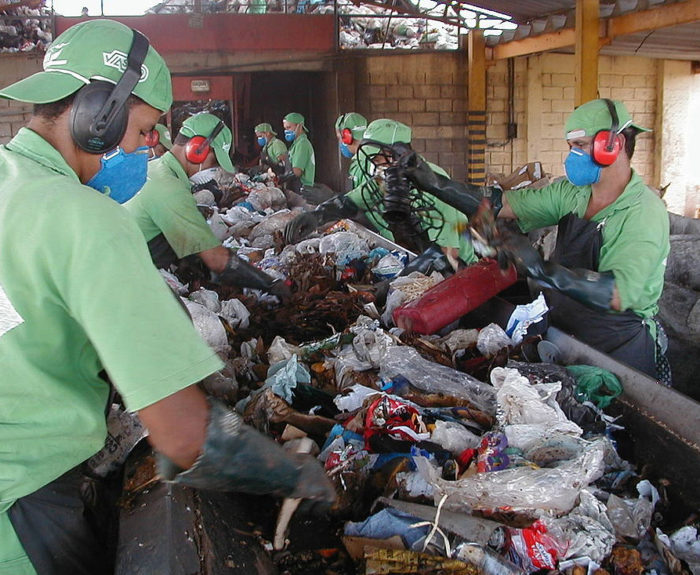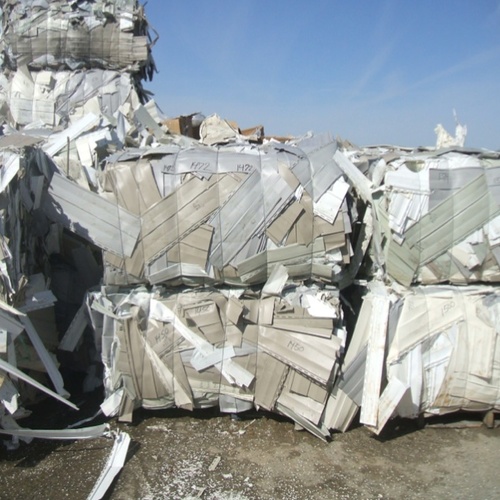
Image Credit: Wikimedia Commons
Some new vinyl flooring tiles contain levels of lead and other contaminants that are far above recommended safety levels because the contents of recycled plastics used to manufacture them aren’t carefully controlled or monitored, according to a study by the Healthy Building Network.
Tests conducted on 74 PVC floor tiles purchased in 2014 and 2015 at six retail stores found the top layer of the tiles was made from virgin PVC and the inner layer contained recycled PVC. On average, the cores of the tiles contained 1,144 parts per million (ppm) of lead and 1,846 ppm of cadmium. The U.S. Consumer Products Safety Commission bars the sale of any products for children that contain more than 100 ppm of lead, the study said. The European Commission prohibits the use of cadmium in new PVC products above levels of 100 ppm.
Testing found a maximum lead level of 10,608 ppm (more than 1 percent of the inner layer) and 22,974 ppm of cadmium (more than 2 percent of the inner layer). The product literature that came with the tiles did not advertise the presence of post-consumer PVC, but the presence of bromine, gold and copper suggested the recycled material came from electronic waste.
One of the Healthy Building Network’s concerns is that inexpensive floor tiles with thin wear layers might expose children to lead and other contaminants if left unrepaired.
“We have identified no research on potential heavy metal exposures from the degradation of PVC floors containing recycled content in the inner layer,” the report says. “But a logical concern is that when floors are damaged, the contents of the inner layer become exposed. The inner layer flooring may reach the surfaces upon which children crawl, and in dust that travels through the air.”
Contamination of recycled plastics a concern
The report notes that manufacturers of building products and the recycling industry have made “significant strides” toward a closed-loop system in which newly manufactured products become the raw materials for products in the future.
“Contamination of feedstocks with chemicals of concern, however, is reducing feedstock value, impeding growth of recycling rates and potentially endangering human health,” the report’s introduction says.
Many manufacturers are abandoning the use of lead and cadmium stabilizers as well as phthalate plasticizers in new products, and these products should lead to cleaner feedstock in the future. But in the meantime, vinyl is such a durable building material that it could take a decade or more before a significant supply of these plastics get into the waste stream and are available as raw materials for new products.
“Recycled PVC must be assumed to contain these additives unless manufacturers provide documentation to the contrary,” the report says. “Chemical (rather than mechanical) recycling processes can eliminate additives of concern from current feedstocks and can better protect workers. However, the technology is nascent and the most common method can create toxic dioxin emissions, not to mention other potential unintended consequences.”
Most recycling of plastics is a labor-intensive process carried out by poorly trained, poorly protected workers who hand-sort waste in small batches and sometimes burn plastics in open pits so they can extract the precious metals they contain, the report says.
Commingling waste streams
Dealing in plastic scrap is a global enterprise, and manufactures often don’t have a very precise idea of what’s in the recycled plastic they use to manufacture new goods, according to this report.
“A variety of PVC types may be commingled in the recycling process, such as those that process both wire and cable insulation and roofing membranes into feedstocks used in new flooring and other building materials,” the report says. “Without proper specifications and screening of the materials streams, the post-consumer PVC used in vinyl flooring is more likely to come from insulation jackets stripped from old cables and wires than from discarded vinyl flooring. These jackets typically contain high levels of heavy metals, problematic plasticizers, and even PCBs.”
The origin and chain-of-custody of recycled PVC are “usually not disclosed to manufacturers, never mind consumers,” the report adds. “Few PVC recycling operations screen their inputs for toxicants,” it says. “European recyclers acknowledge, in submissions to the European Commission, that phthalates and toxic metal stabilizers remain in the recycled PVC feedstocks that they currently produce, and that these substances are present above regulatory thresholds of concern.”
Some flooring manufacturers are taking the lead
The report singles out several manufacturers for making efforts to keep contaminated plastics out of the flooring or carpeting they produce, including Armstrong, Interface, and Tarkett.
Armstrong uses only flooring waste for post-consumer recycled content in new flooring, as does Interface for its carpeting. Tarkett, the report says, has adopted an “aggressive phthalate standard” for its PVC resilient flooring and carpets and phased out virgin phthalates from all of their products. In addition, Tarkett has stopped using any post-consumer PVCs at its European plants and prohibits its use by Asian suppliers.
The report says the first step toward establishing quality control in the supply chain for building products is to understand the source of recycled plastics. “Much more clarity is needed in this industry,” the report says. “Tracking the trail of PVC waste, from production to processing, would help manufacturers identify potential contents of concern. From this knowledge, companies can most efficiently target substances [to be] tested and eliminated from the recycled feedstock.”
Testing was carried out by the Ecology Center of Ann Arbor, Michigan. The Healthy Building Network summary does not list the eight brands of flooring that were tested, nor does it mention the names and locations of the stores where samples were purchased.
But Ecology Center Research Director Jeff Gearhart shed some light on those questions when he said that the samples were the same as those listed in an earlier report on phthalates in vinyl flooring, which the Center published in April.
The retailers included Ace Hardware, Build.com, Lowe’s, Lumber Liquidators, and Menards. Samples were purchased in seven states: Connecticut, Massachusetts, Maine, Michigan, North Carolina, New York, and Vermont.
Gearhart said by telephone that the Center hadn’t been specific about the source of flooring samples because it is still conducting phthalate tests on the backing, or inner layer.
Weekly Newsletter
Get building science and energy efficiency advice, plus special offers, in your inbox.













0 Comments
Log in or create an account to post a comment.
Sign up Log in